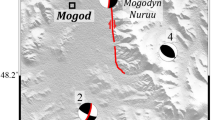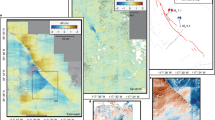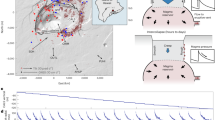Abstract
CRUSTAL deformations along fault zones are monitored because they show the accumulation and possible premonitory release of strain energy before major earthquakes. On the Parkfield segment of the San Andreas fault the next mainshock (local magnitude ML=5.7) is expected to occur between 1983 and 1993, based on the relatively regular recurrence of characteristic earthquakes in 1857, 1881, 1901, 1922, 1934 and 19661. A concerted monitoring effort is therefore underway at Parkfield, with the aim of detecting precursory changes in observable quantities that can be measured reliably2. Here we report data from two geodetic lines crossing the San Andreas fault near Parkfield which show that the rate of shortening decreased by ˜20% starting in August 1986. This change coincided with a rate decrease of 45% for earthquakes of ML⩾2.1 in the area3,4. Both phenomena may have been caused by temporary locking of the fault surface, or a decrease in strain accumulation rate, and they are interpreted as intermediate-term precursors to the next Parkfield earthquake.
This is a preview of subscription content, access via your institution
Access options
Subscribe to this journal
Receive 51 print issues and online access
$199.00 per year
only $3.90 per issue
Buy this article
- Purchase on Springer Link
- Instant access to full article PDF
Prices may be subject to local taxes which are calculated during checkout
Similar content being viewed by others
References
Bakun, W. H. & McEvilly, T. V. J. geophys. Res. 89, 3051–3058 (1984).
Bakun, W. H. & Lindh, A. G. Science 229, 619–624 (1985).
Bodin, P., Wyss, M. & Habermann, R. E. Eos 70, 1230 (1989).
Wyss, M., Bodin, P. & Habermann, R. E. Nature 345, 426–428 (1990).
Slater, L. E. & Huggett, G. R. J. geophys. Res. 81, 6299–6306 (1976).
Burford, R. O. & Slater, L. E. U.S. Geol. Survey, Open File Report 85-754, 117–129 (1985).
Langbein, L. E., Burford, R. O. & Slater, L. E. J. geophys. Res. 95, 2533–2552 (1990).
Aviles, C. A. & Valdes, C. M. Eos 70, 1228 (1989).
Wyss, M. & Burford, R. O. U.S. Geol. Survey, Open File Report 85-745, 367–426 (1985).
Wyss, M. & Burford, R. O. Nature 329, 323–325 (1987).
Burford, R. O., Schulz, S. S. & Simpson, R. W. U.S. Geol. Survey Open File Report 87-591, 845–867 (1987).
Simpson, R. W., Schulz, S. S., Dietz, L. D. & Burford, R. O. Pure appl. Geophys. 126, 665–685 (1988).
Burford, R. O. Pure appl. Geophys. 126, 499–529 (1988).
Scholz, C. H. Bull. seism. Soc. Am. 58, 399–416 (1968).
Wyss, M. Geophys. JI R. astr. Soc. 31, 341–359 (1973).
Stuart, W. D. J. geophys. Res. 84, 1063–1070 (1979).
Allen, C. R. & Smith, S. W. Bull. seism. Soc. Am. 56, 966–967 (1966).
Brown, R. D. Jr et al. Geol. Surv. prof. Pap. U.S. 597, (1967).
Author information
Authors and Affiliations
Rights and permissions
About this article
Cite this article
Wyss, M., Slater, L. & Burford, R. Decrease in deformation rate as a possible precursor to the next Parkfield earthquake. Nature 345, 428–431 (1990). https://doi.org/10.1038/345428a0
Received:
Accepted:
Issue Date:
DOI: https://doi.org/10.1038/345428a0
This article is cited by
-
Surface Deformation and Seismic Rebound: Implications and Applications
Surveys in Geophysics (2011)
-
Gravity changes before large earthquakes in China: 1998–2005
Geo-spatial Information Science (2011)
-
Anomalies of Seismic Activity and Transient Crustal Deformations Preceding the 2005 M 7.0 Earthquake West of Fukuoka
Pure and Applied Geophysics (2010)
-
Case 23 nomination of precursory seismic quiescence as a significant precursor
Pure and Applied Geophysics PAGEOPH (1997)
-
Fluid-mediated influence of adjacent thrusting on the seismic cycle at Parkfield
Nature (1996)
Comments
By submitting a comment you agree to abide by our Terms and Community Guidelines. If you find something abusive or that does not comply with our terms or guidelines please flag it as inappropriate.



